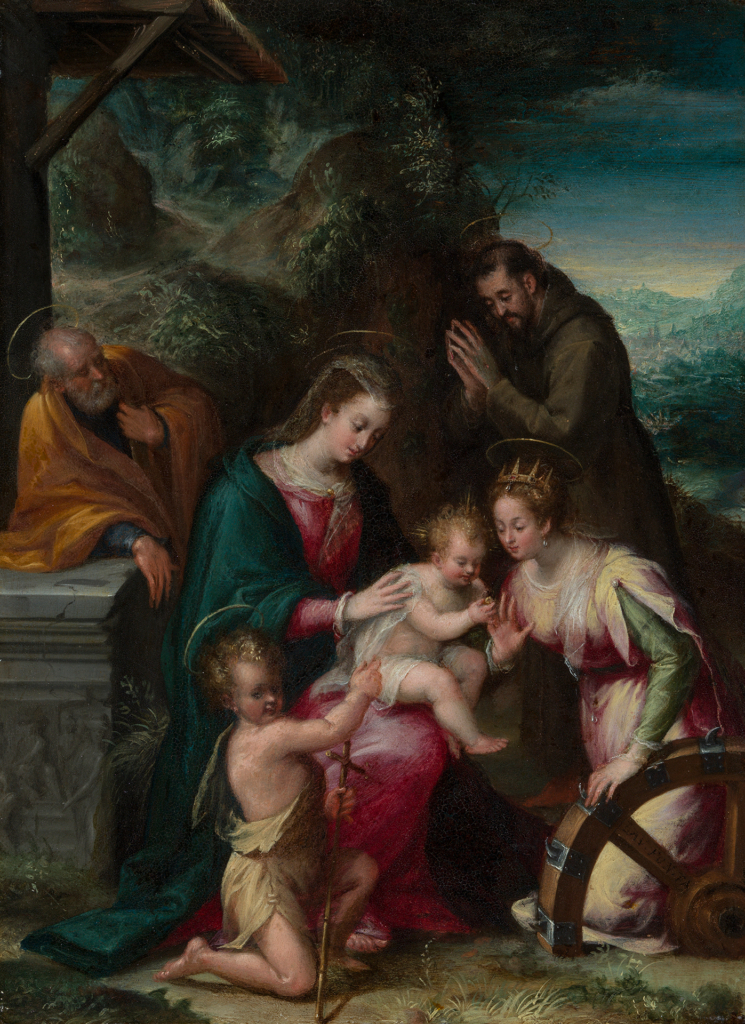
| X (Twitter) | |
|---|---|
URL kopieren
Die URL wurde erfolgreich kopiert und befindet sich in der Zwischenablage |
|
Aus urheberrechtlichen Gründen können wir die Werkabbildung leider nicht zum Download bereitstellen.
Hier erfahren Sie mehr.Mystical wedding Katharina
Lavinia Fontana
KunsthalleKarlsruhe@ZKM
Art History With or Without Names
0:00
0:00
A Short Story about a Great Painter
Bologna, Italy, circa 1550 — a mid-sized Italian city known to this day for its university founded in 1088 CE. Here begins the story of a woman who, with her expressive portraits and sensitive devotional paintings, indeed her way of painting in general, impressed not only her contemporaries (including the Pope), but also continues to fascinate art lovers in the present day. Her name: Lavinia Fontana.
The City of Women
Surprisingly, it was actually because Bologna belonged to the Papal States after its conquest by Pope Julius II in 1506 that the city offered certain opportunities for women to develop and flourish. In order to pursue their professions successfully, many of Bologna’s men were obliged to travel regularly to Rome, the heart of the Papal States, for extended periods of time, and were thus frequently absent. However, if they did not want to relinquish their standing in Bologna to competing families, these men had no choice but to entrust their wives with the temporary management of the business on their behalf. This resulted in an intriguing melange that gave rise to a self-confident and independently acting class of wealthy ladies. To no small degree it was the commissions from these clients, who were always on the lookout for artworks befitting their status, that made Lavinia Fontana’s extraordinary career possible.
In the Name of Art
In Lavinia Fontana’s private life the then traditional sex roles were reversed: she was the breadwinner earning a living as a painter while her husband brought up the children. He also helped out in his wife’s studio and painted parts of backgrounds. In one respect, however, even this very successful painter had to bow to the laws of her time. Instead of negotiating her commissions herself, as her male colleagues did, Fontana’s husband had to act as her agent. For financial transactions were not undertaken by women on their own at this time; a state of affairs that was to last for several centuries. Pope Clement VII was unimpressed by any considerations of gender and summoned Lavinia Fontana to Rome, where she became the first female artist in Bologna to be accepted into the renowned artists’ association Accademia di San Luca, where she executed large-scale altarpieces.
“Fontana” for the Kunsthalle
It is to an art lover and collector who particularly appreciated the talent of this artist that the Staatliche Kunsthalle Karlsruhe is indebted for the painting by Lavinia Fontana, which has only recently enriched the museum’s collection. Dr. Hermann Röchling had a special love for works on copperplate and admired Fontana’s painting of the Mystical Marriage of Saint Catherine so much that he named his foundation after Lavinia Fontana. The Fontana Foundation for the promotion of social, charitable, and cultural aims also supports, among others, the Kunsthalle Karlsruhe. This closes the circle of a benefactor’s special appreciation for an extraordinary artist.
Dates and facts
| Title | Mystical wedding Katharina |
|---|---|
| Artist | Lavinia Fontana |
| Date | around 1575 |
| Measurements Painting | H 25.7cm W 19.5cm D 0.6cm |
| Material | Oil on copper |